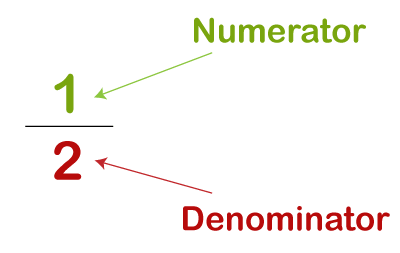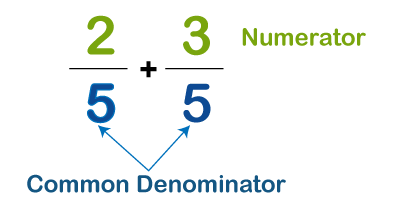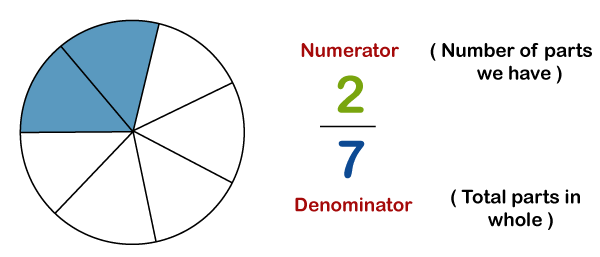What is a denominator?In this article, we are going to discuss about denominator's definition. Here, we will discuss the examples of the denominator, brief of LCD (Least common denominator), rationalizing the denominator, and the difference between the numerator and denominator. We will also discuss some frequently asked questions (FAQs) related to the denominator. Definition of denominatorBefore defining the denominator, let's first understand the term fraction. Fractions are the number written in the form of p/q, where p is the numerator and q is the denominator. The denominator is the divisor of the fraction or the number which is written below the fraction's line. In short in a fraction, the bottom number is said to be a denominator. 
When a number is represented in a fraction, two numbers will appear separated by a horizontal line (-) or by a slash (/). The number written below the horizontal line is the denominator of the fraction. It is not compulsory that only numbers can be expressed in fractional form. We can also express the variables in the form of numerator and denominator, for instance, x/y, p/q, and many more, and y and q in these fractions are the denominators. The concept of denominators is widely used in ratio and proportions. NOTE: The value of the denominator should not be zero because if the denominator is zero, a fraction will be undefined. As an instance, the fraction 7/0 is undefined because the denominator's value is zero.Examples of denominatorHere, we are tabulating some of the examples of denominator that helps you to understand the concept more clearly. We are writing fractions in the first column, and the denominator of the corresponding fraction will be written in the second column.
Numerator v/s DenominatorThe difference between both terms are listed as follows -
What is the common denominator?Now, let's discuss the term common denominator. When two fractions have the same denominator value, then they are the common denominators. During the addition or subtraction of fractions, we generally required the same or common denominators. But if they are different, we have to find the LCD of fractions before adding or subtracting them. 
The least common denominator (LCD) is the LCM of two numbers. It is generally used when we add, subtract, or compare the fractions. The least common denominator is required because we cannot add fractions with different denominators. We can multiply the fractions together whether their denominators are equal or not. We can understand it via some examples.
To understand about Least common denominator and methods to find it, you can refer to the link - Least Common Denominator Now, let's discuss rationalizing the denominator. Rationalizing the denominatorRationalization of a denominator is required when it is an irrational number so that further calculations can be easily done on the fraction. The irrational denominator includes the root numbers. Now, first, understand the term rationalizing. So, rationalizing means multiplying a surd with another similar surd to get the result in a rational number. The surd used for multiplication is called the rationalizing factor. As an instance, suppose we have to rationalize 2√3, so the rationalizing factor for 2√3 is √3 - 2√3 x √3 = 2 x 3 = 6. Now, let's see the rationalization of the monomial denominator and binomial denominator. Rationalizing the monomial denominator2/√3 includes an irrational denominator that is the cube root of 3. So, to remove the radical, we have to multiply the numerator and denominator of the given number by √3. Therefore, on multiplying both denominator and numerator of the given by √3, we will get, (2/√3) x (√3/√3) = 2√3/3 Rationalizing the binomial denominatorWhen the denominator includes two terms, then it will be irrational. Suppose we have the number (2)/(5+√3), so in this case, we have to multiply both numerator and denominator by the conjugate of the given denominator. Conjugate means the same denominator with opposite signs. Therefore, the conjugate of 5 + √3 is 5 - √3 (here, the plus sign is replaced with the minus sign). On rationalizing (2)/(5+√3), we will get - [(2)/(5+√3)] x [(5-√3)/(5-√3)], which will be equivalent to - = (10 - 2√3) / (52 - (√3)2) = (10 - 2√3) / (22) Now, let's solve some of the questions to find the denominator of the given fractions. QuestionsQuestion 1 - John ordered a pizza at a restaurant. Every piece of pizza is representing a part of the whole. Suppose the pizza is divided into 6 parts. If john ate one slice, what will be the denominator of the fraction representing the amount of pizza john ate? Answer 1 - Given, total number of pizza slices = 6 Number of pieces john ate = 1 So, the fraction of the pizza is 1/6. Here, the number 6 is representing the total number of slices in the pizza. So, the denominator is 6. Question 2 - Lily bought an apple and cut it into 4 pieces. If she gives one piece to her child, what will be the fraction of the remaining apple, and also what will be the denominator of the remaining apple's fraction? Answer 2 - Given, the total number of pieces of the apple = 4 After removing one piece, number of pieces left = 3 Therefore, the fraction of remaining apple = 3/4 So, the denominator is 4. Question 3 - Draco wants to find a fraction that shows the vowel to the total number of characters in his name. What will be the fraction and the denominator of the fraction formed? Answer 3 - Total number of characters in the name of Draco = 5 Number of vowels in his name = 2 ('a' and 'o') So, the Fraction is = 2/5 And the required denominator is 5 that represents the total number of characters in Draco's name. Question 4 - Rationalize the denominator of 1/√4. Answer 4 - To rationalize 1/√4, we require the rationalizing factor, i.e., √4 So, multiply √4 to the numerator and denominator of the given fraction, i.e., = (1/√4) x (√4/√4) = √4/4 So, the answer is √4/4. Question 5 - Rationalize the denominator of √5/(2+√3). Answer 5 - Here, we have to multiply both numerator and denominator by the conjugate of the given denominator. Therefore, the conjugate of 2+√3 is 2-√3 (here, the plus sign is replaced with the minus sign). On rationalizing (√5)/(2+√3), we will get - [(√5)/(2+√3))] x [(2-√3)/( 2-√3)], which will be equivalent to - = √5(2 - √3) / (22 - (√3)2) = √5(2 - √3) / (4-3) = √5(2 - √3) / 1 or, = √5(2 - √3) Now, let's see some of the frequently asked questions (FAQs) related to the denominator. Frequently Asked Questions (FAQs)Question1 - What is a denominator? Answer1 - The denominator is the divisor of the fraction or the number which is written below the fraction's line. In short in a fraction, the bottom number is said to be a denominator. Question2 - Can a value of denominator be zero? Answer2 - The value of denominator should not be zero, because if denominator is zero, fraction will be undefined. Question3 - State the comparison between numerator and denominator. Answer3 - In a fraction, the numerator is the top part, and the denominator is the bottom number. A denominator indicates the total number of equal parts in which the entire thing is divided, whereas a numerator indicates the number of selected divisions that have been selected from the total number of parts. Question4 - What is the meaning of the common denominator? Answer4 - When two fractions have the same denominator value, then they are the common denominators. Question5 - What is the conjugate of a number? Answer5 - Conjugate means the same denominator with opposite signs. Suppose the number is 5 + √3 so, the conjugate of 5 + √3 is 5 - √3 (here, the plus sign is replaced with the minus sign). So, that's all about the denominator. Here, we have discussed many terms along with the definition of the denominator. We have also solved some questions on the denominator and discussed some frequently asked questions related to the denominator.
Next TopicWindows shortcut commands
|
 For Videos Join Our Youtube Channel: Join Now
For Videos Join Our Youtube Channel: Join Now
Feedback
- Send your Feedback to [email protected]
Help Others, Please Share










